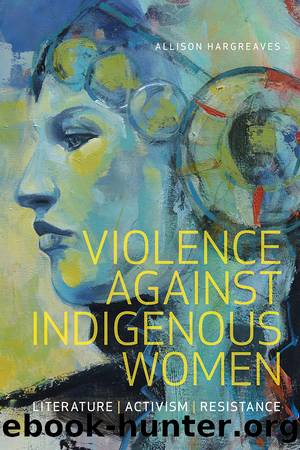Violence Against Indigenous Women by Allison Hargreaves

Author:Allison Hargreaves [Allison Hargreaves]
Language: eng
Format: epub
Publisher: Wilfrid Laurier University Press
Published: 2017-03-15T00:00:00+00:00
CHAPTER FOUR
Recognition, Remembrance, and Redress: The Politics of Memorialization in the Cases of Helen Betty Osborne and Anna Mae Pictou-Aquash
This chapter returns our attention to storytelling as a means of remembrance, as a consciousness-raising tool, and as a catalyst toward action. However, while I formerly explored the possibilities and limits of storytelling the âhuman termsâ of violence against Indigenous women,1 I now turn to the related question of how some anti-violence initiatives, in their work to grant a âhuman face to the mounting number of victims,â2 have gravitated toward certain âfacesâ in particular. Storytelling has emerged as an inveterate strategy of anti-violence campaigns; what, then, of those recurring figures whose individual stories are told and retold? While the telling of individual womenâs stories is often imagined as a way to both âraise awarenessâ and promote ârecommendations to influence positive change,â3 I want to explore how certain exemplary cases seem to have circulated more readily as appropriate ambassadors for the cause. In this discussion, I am curious about the intersection between selective memorial practices, and the educative as well as âreparativeâ functions they ostensibly serve.4 In exploring the performative links between commemoration, consciousness raising, and the move toward reparation or redress, I hope to trouble what is often assumed to be the unmediated relation between these practices and to question the ironic capacity of these practices to enact the very hierarchization of human life they protest against. And it is precisely because of (rather than in spite of) the urgency and necessity of combating indifference, raising awareness, and promoting social change that I want to unpack the sometimes unforeseen and unintended consequences implied in the valuing of some victims of violence as more illustrative, more affecting, or more instructive than others.
Many anti-violence critics have pointed to the âoverexposure to violence and abuseâ that results from the systemic marginalization of Indigenous women in the âareas of social engagement, education and economic opportunities, cultural practices, political action, and civil/human rights.â5 Others have critiqued delayed or inadequate media coverage as itself a discursive form of violence. As Laurie McNeill observes, material and discursive forms of marginalization are connected, with many Indigenous womenâs cases garnering scant attention in the public eye: âAs in life, some dead continue to be marginalized.â6 Specifically, McNeill highlights, via Judith Butlerâs notion of âgrievability,â the racialized hierarchy of human loss legible in the âgap between official and marginalizedâ victims of violence.7 For McNeill, commemoration itself constitutes a particular rhetorical practice in which one can readâin the precise presences and absences it marksâa discerning of just âwhose lives countâ in so-called âcollective memory.â8 Not surprisingly, in these kinds of reckonings, Indigenous womenâs lives have decidedly counted less.
In resistance to a dominant public discourse characterized by apathetic, indifferent, or even incredulous responses to the social reality of missing and murdered women, various anti-violence campaigns have fashioned for public consumption the stories of certain emblematic figures of victimryâfigures who, from the frequency with which they circulate, seem especially capable of revealing âthe truth of societyâs treatment of aboriginal people.
Download
This site does not store any files on its server. We only index and link to content provided by other sites. Please contact the content providers to delete copyright contents if any and email us, we'll remove relevant links or contents immediately.
Cecilia; Or, Memoirs of an Heiress — Volume 1 by Fanny Burney(32026)
Cecilia; Or, Memoirs of an Heiress — Volume 3 by Fanny Burney(31439)
Cecilia; Or, Memoirs of an Heiress — Volume 2 by Fanny Burney(31387)
The Great Music City by Andrea Baker(30759)
We're Going to Need More Wine by Gabrielle Union(18609)
All the Missing Girls by Megan Miranda(14625)
Pimp by Iceberg Slim(13755)
Bombshells: Glamour Girls of a Lifetime by Sullivan Steve(13667)
Fifty Shades Freed by E L James(12889)
Talking to Strangers by Malcolm Gladwell(12826)
Norse Mythology by Gaiman Neil(12794)
For the Love of Europe by Rick Steves(11339)
Crazy Rich Asians by Kevin Kwan(8865)
Mindhunter: Inside the FBI's Elite Serial Crime Unit by John E. Douglas & Mark Olshaker(8668)
The Lost Art of Listening by Michael P. Nichols(7138)
Enlightenment Now: The Case for Reason, Science, Humanism, and Progress by Steven Pinker(6856)
The Four Agreements by Don Miguel Ruiz(6289)
Bad Blood by John Carreyrou(6258)
Weapons of Math Destruction by Cathy O'Neil(5804)
